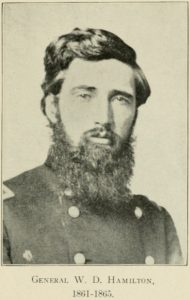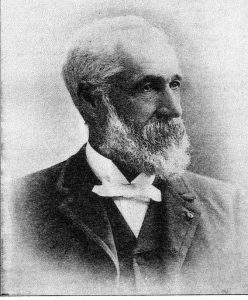William Douglas Hamilton was born in Lanarkshire, Scotland on May 24, 1832. He immigrated to the United States with his parents and two siblings six years later, and the family settled on a 200-acre farm near Newark in Licking County, Ohio. Two uncles had had settled in Ohio three years earlier, and parents followed their brothers to America, settling in a a Scottish enclave that developed along the National Road in Central Ohio.
As a youth, he worked on the farm and then taught school to earn his way through college and then law school. He graduated from Ohio Wesleyan College in Delaware, Ohio and from the Cincinnati Law School in 1859. He then established a law office in Zanesville and practiced law until the outbreak of the Civil War in 1861. When Fort Sumter was shelled in April 1861, Hamilton was recuperating from typhoid fever. He immediately decided to enlist.
Abandoning his law practice, he raised the first company for three years’ service in that part of Ohio, and was assigned to the 32nd Ohio Volunteer Infantry as captain of Company G. He served in the West Virginia and Shenandoah Valley campaigns of 1861 and 1862. Fortunately, he was at home in Zanesville on recruiting duty when his regiment surrendered to Maj. Gen. Thomas J. “Stonewall” Jackson’s troops at Harpers Ferry in September 1862, so he avoided that disgrace.
In December 1862, Ohio Governor David Tod directed Hamilton to recruit the 9th Ohio Cavalry. The regiment was organized in 1863 for three years’ service. The first four companies mustered in at Zanesville in January 1863, and it took until September, October, and December for the remaining eight companies to be mustered into service. The first four companies were organized as a battalion and placed under Hamilton’s command. The regiment was finally completed and united in Alabama in early 1864. Hamilton was originally commissioned as a major of the new regiment, earning promotions to lieutenant colonel in 1863, and finally to colonel later that year. He was known as an officer who “takes great care of his soldiers” and who “does not let them suffer.” Two brothers, Robert and Henry, also enlisted in the same company and were killed during the war.
The 9th Ohio Cavalry served honorably in the Atlanta Campaign, the March to the Sea, and the Carolinas Campaign. In particular, Hamilton and the 9th Ohio served critical roles in the December 4, 1864 Battle of Waynesboro, Georgia during the March to the Sea, and at the February 11, 1865 Battle of Aiken, South Carolina, where a cousin, Lt. Arthur Hamilton, the regimental adjutant of the 9th Ohio Cavalry, was mortally wounded.In all, William D. Hamilton served one year in the infantry and then three years in the cavalry during the course of the American Civil War. Among the battles he participate din were Cheat Mountain, Decatur, Buckhead Creek, Waynesboro, Aiken, Averasboro, and Bentonville. He was brevetted to brigadier general of volunteers for “gallant and meritorious service rendered during the campaign ending in the surrender of the insurgent armies of Johnson and Lee” upon recommendation by Sherman and Judson Kilpatrick.
After the Civil War, Hamilton abandoned the practice of law and became an industrialist in the coal and iron business. He successively was president of a rolling mill company located in Newark, Ohio. He organized and served as treasurer of the Newark, Somerset and Shawnee Railroad, which was later purchased by the Baltimore and Ohio Railroad. He then served as president of the Ogden Iron Company at Orbiston, Hocking County, Ohio, which later merged with another company. Then, he acted as president of the Hamilton Coal and Iron Company, operating in Athens County, Ohio. Finally, his last role was as president of the Southern Slate Company.Hamilton was a Republican, a member of the Wells Post, G.A.R., in Columbus, Ohio, the Military Order of the Loyal Legion of the United States, and the First Congregational Church in Columbus. He published a well-regarded memoir of his wartime service in 1915 titled Personal Recollections of a Cavalryman After Fifty Years.
Hamilton married Sarah Cheaver Abbott of Zanesville in 1866. The couple had two daughters, Mrs. C. E. Gillette, wife of Major Gillette of Philadelphia, and Mrs. Charles E. Sudler, of Chilhowee, Tennessee and two sons, William E. Hamilton of Columbus and Charles R. Hamilton of Cleveland. His grandson, Douglas Hamilton Gillette, was a member of the West Point Class of 1915, and Hamilton dedicated his memoir to his grandson.
Hamilton died in Columbus, Ohio on January 22, 1916, and was buried in an unmarked grave in Greenlawn Cemetery. Sarah Hamilton died in 1920 and was buried alongside her husband. She also rests in an unmarked grave.
The Central Ohio Civil War Roundtable has made the marking of General and Mrs. Hamilton’s graves a group project. We hope that it will come to fruition during 2018, as this forgotten horse soldier deserves recognition for his honorable service during the Civil War.
Here’s to William Douglas Hamilton, forgotten Ohio cavalryman.
Scridb filterNotice: Undefined index: id in /home/netscrib/public_html/civilwarcavalry/wp-content/themes/wittenberg/footer.php on line 8
Notice: Undefined index: id in /home/netscrib/public_html/civilwarcavalry/wp-content/themes/wittenberg/footer.php on line 8
Notice: Undefined index: std in /home/netscrib/public_html/civilwarcavalry/wp-content/themes/wittenberg/footer.php on line 8
Notice: Undefined index: id in /home/netscrib/public_html/civilwarcavalry/wp-content/themes/wittenberg/footer.php on line 8
Notice: Undefined index: id in /home/netscrib/public_html/civilwarcavalry/wp-content/themes/wittenberg/footer.php on line 8
Notice: Undefined index: std in /home/netscrib/public_html/civilwarcavalry/wp-content/themes/wittenberg/footer.php on line 8
Notice: Undefined index: id in /home/netscrib/public_html/civilwarcavalry/wp-content/themes/wittenberg/footer.php on line 8
Notice: Undefined index: id in /home/netscrib/public_html/civilwarcavalry/wp-content/themes/wittenberg/footer.php on line 8
Notice: Undefined index: std in /home/netscrib/public_html/civilwarcavalry/wp-content/themes/wittenberg/footer.php on line 8
Notice: Undefined index: id in /home/netscrib/public_html/civilwarcavalry/wp-content/themes/wittenberg/footer.php on line 8
Notice: Undefined index: id in /home/netscrib/public_html/civilwarcavalry/wp-content/themes/wittenberg/footer.php on line 8
Notice: Undefined index: std in /home/netscrib/public_html/civilwarcavalry/wp-content/themes/wittenberg/footer.php on line 8
Notice: Undefined index: id in /home/netscrib/public_html/civilwarcavalry/wp-content/themes/wittenberg/footer.php on line 8
Notice: Undefined index: id in /home/netscrib/public_html/civilwarcavalry/wp-content/themes/wittenberg/footer.php on line 8
Notice: Undefined index: std in /home/netscrib/public_html/civilwarcavalry/wp-content/themes/wittenberg/footer.php on line 8
Notice: Undefined index: id in /home/netscrib/public_html/civilwarcavalry/wp-content/themes/wittenberg/footer.php on line 8
Notice: Undefined index: id in /home/netscrib/public_html/civilwarcavalry/wp-content/themes/wittenberg/footer.php on line 8
Notice: Undefined index: std in /home/netscrib/public_html/civilwarcavalry/wp-content/themes/wittenberg/footer.php on line 8
Notice: Undefined index: id in /home/netscrib/public_html/civilwarcavalry/wp-content/themes/wittenberg/footer.php on line 8
Notice: Undefined index: id in /home/netscrib/public_html/civilwarcavalry/wp-content/themes/wittenberg/footer.php on line 8
Notice: Undefined index: std in /home/netscrib/public_html/civilwarcavalry/wp-content/themes/wittenberg/footer.php on line 8
Notice: Undefined index: id in /home/netscrib/public_html/civilwarcavalry/wp-content/themes/wittenberg/footer.php on line 8
Notice: Undefined index: id in /home/netscrib/public_html/civilwarcavalry/wp-content/themes/wittenberg/footer.php on line 8
Notice: Undefined index: std in /home/netscrib/public_html/civilwarcavalry/wp-content/themes/wittenberg/footer.php on line 8
Notice: Undefined index: id in /home/netscrib/public_html/civilwarcavalry/wp-content/themes/wittenberg/footer.php on line 8
Notice: Undefined index: id in /home/netscrib/public_html/civilwarcavalry/wp-content/themes/wittenberg/footer.php on line 8
Notice: Undefined index: std in /home/netscrib/public_html/civilwarcavalry/wp-content/themes/wittenberg/footer.php on line 8
Notice: Undefined index: id in /home/netscrib/public_html/civilwarcavalry/wp-content/themes/wittenberg/footer.php on line 8
Notice: Undefined index: id in /home/netscrib/public_html/civilwarcavalry/wp-content/themes/wittenberg/footer.php on line 8
Notice: Undefined index: std in /home/netscrib/public_html/civilwarcavalry/wp-content/themes/wittenberg/footer.php on line 8
Notice: Undefined index: id in /home/netscrib/public_html/civilwarcavalry/wp-content/themes/wittenberg/footer.php on line 8
Notice: Undefined index: id in /home/netscrib/public_html/civilwarcavalry/wp-content/themes/wittenberg/footer.php on line 8
Notice: Undefined index: std in /home/netscrib/public_html/civilwarcavalry/wp-content/themes/wittenberg/footer.php on line 8
Notice: Undefined index: id in /home/netscrib/public_html/civilwarcavalry/wp-content/themes/wittenberg/footer.php on line 8
Notice: Undefined index: id in /home/netscrib/public_html/civilwarcavalry/wp-content/themes/wittenberg/footer.php on line 8
Notice: Undefined index: std in /home/netscrib/public_html/civilwarcavalry/wp-content/themes/wittenberg/footer.php on line 8
Notice: Undefined index: id in /home/netscrib/public_html/civilwarcavalry/wp-content/themes/wittenberg/footer.php on line 8
Notice: Undefined index: id in /home/netscrib/public_html/civilwarcavalry/wp-content/themes/wittenberg/footer.php on line 8
Notice: Undefined index: std in /home/netscrib/public_html/civilwarcavalry/wp-content/themes/wittenberg/footer.php on line 8
Notice: Undefined index: id in /home/netscrib/public_html/civilwarcavalry/wp-content/themes/wittenberg/footer.php on line 8
Notice: Undefined index: id in /home/netscrib/public_html/civilwarcavalry/wp-content/themes/wittenberg/footer.php on line 8
Notice: Undefined index: std in /home/netscrib/public_html/civilwarcavalry/wp-content/themes/wittenberg/footer.php on line 8
Notice: Undefined index: id in /home/netscrib/public_html/civilwarcavalry/wp-content/themes/wittenberg/footer.php on line 8
Notice: Undefined index: id in /home/netscrib/public_html/civilwarcavalry/wp-content/themes/wittenberg/footer.php on line 8
Notice: Undefined index: std in /home/netscrib/public_html/civilwarcavalry/wp-content/themes/wittenberg/footer.php on line 8
Notice: Undefined index: id in /home/netscrib/public_html/civilwarcavalry/wp-content/themes/wittenberg/footer.php on line 8
Notice: Undefined index: id in /home/netscrib/public_html/civilwarcavalry/wp-content/themes/wittenberg/footer.php on line 8
Notice: Undefined index: std in /home/netscrib/public_html/civilwarcavalry/wp-content/themes/wittenberg/footer.php on line 8
Notice: Undefined index: id in /home/netscrib/public_html/civilwarcavalry/wp-content/themes/wittenberg/footer.php on line 8
Notice: Undefined index: id in /home/netscrib/public_html/civilwarcavalry/wp-content/themes/wittenberg/footer.php on line 8
Notice: Undefined index: std in /home/netscrib/public_html/civilwarcavalry/wp-content/themes/wittenberg/footer.php on line 8
Notice: Undefined index: id in /home/netscrib/public_html/civilwarcavalry/wp-content/themes/wittenberg/footer.php on line 8
Notice: Undefined index: id in /home/netscrib/public_html/civilwarcavalry/wp-content/themes/wittenberg/footer.php on line 8
Notice: Undefined index: std in /home/netscrib/public_html/civilwarcavalry/wp-content/themes/wittenberg/footer.php on line 8
Notice: Undefined index: id in /home/netscrib/public_html/civilwarcavalry/wp-content/themes/wittenberg/footer.php on line 8
Notice: Undefined index: id in /home/netscrib/public_html/civilwarcavalry/wp-content/themes/wittenberg/footer.php on line 8
Notice: Undefined index: std in /home/netscrib/public_html/civilwarcavalry/wp-content/themes/wittenberg/footer.php on line 8
Notice: Undefined index: id in /home/netscrib/public_html/civilwarcavalry/wp-content/themes/wittenberg/footer.php on line 8
Notice: Undefined index: id in /home/netscrib/public_html/civilwarcavalry/wp-content/themes/wittenberg/footer.php on line 8
Notice: Undefined index: std in /home/netscrib/public_html/civilwarcavalry/wp-content/themes/wittenberg/footer.php on line 8
Notice: Undefined index: id in /home/netscrib/public_html/civilwarcavalry/wp-content/themes/wittenberg/footer.php on line 8
Notice: Undefined index: id in /home/netscrib/public_html/civilwarcavalry/wp-content/themes/wittenberg/footer.php on line 8
Notice: Undefined index: std in /home/netscrib/public_html/civilwarcavalry/wp-content/themes/wittenberg/footer.php on line 8









 Back to top
Back to top Blogs I like
Blogs I like 
Comments
Comments are closed.